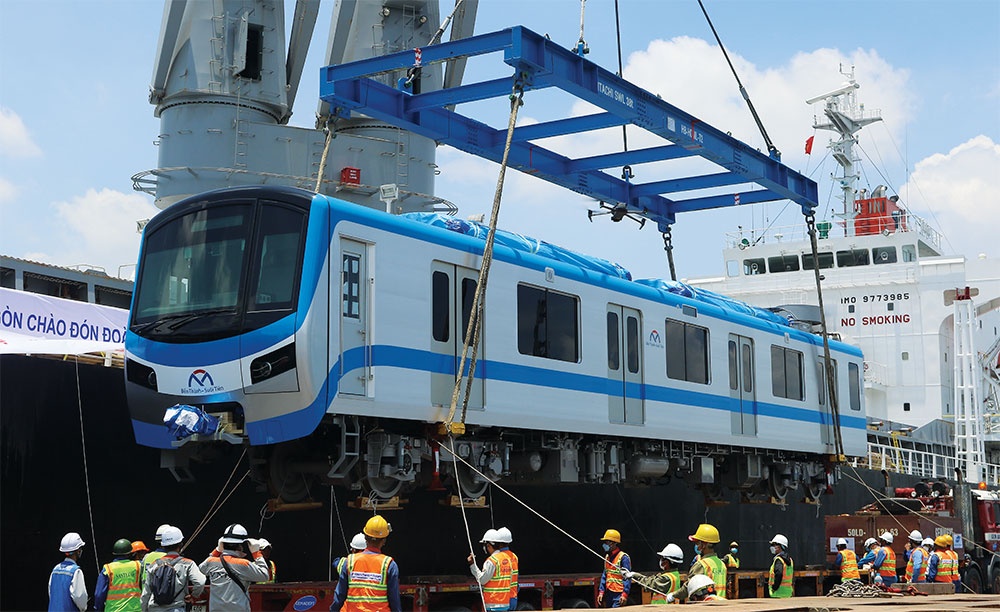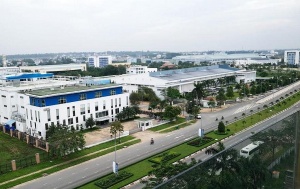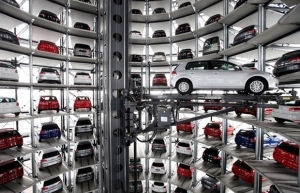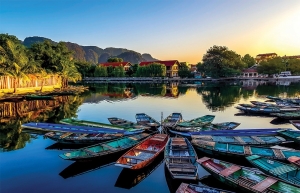Seizing the chance for a rebound
 |
| Metro lines linking Ho Chi Minh City to its environs have begun testing |
In Dong Nai province since the beginning of 2021, the local authorities has approved various foreign-invested enterprises such as Japan’s Ojitex Vietnam and South Korea’s Hansol Electronics Vietnam and Platel Vina for their industrial zone ventures.
Nguyen Hong Linh, Secretary of Dong Nai Party Committee, stated that whereas 50 years ago, all economic activities in the southeast region revolved around Tan Son Nhat International Airport and Saigon Port in Ho Chi Minh City, the new focus of the Southern Key Economic Zone will be areas with numerous development potential for connection infrastructure, such as Long Thanh International Airport in Dong Nai and Cai Mep Port in Ba Ria-Vung Tau.
“Once two new focus points are established, all traffic in the region will be redirected to these two sites. The routes with the lowest and quickest costs have the benefits and each of these new focus areas creates a substantial competitive advantage,” he highlighted.
The secretary then indicated that the infrastructure system, particularly the traffic of Dong Nai and the southern key economic region, will undergo a radical overhaul in the near future.
Together with Cai Mep Port, development of Long Thanh International Airport has become a magnet, bringing local and foreign capital flows to places such as Dong Nai, Binh Duong, Ba Ria-Vung Tau, and Binh Thuan.
Alongside Dong Nai, Ba Ria-Vung Tau is one of the southern locations that consistently earns high overseas funding attractiveness rankings. The province has attracted over 440 foreign-invested projects with the total registered capital of approximately $30 billion from 30 countries and territories. This includes 270 projects in industrial zones (IZs) worth $12.23 billion and 170 outside IZs registered at $17.67 billion.
Adjacent regions also benefit from the upcoming Long Thanh and Cai Mep. For instance, Becamex IDC’s decision to invest in Becamex VSIP Binh Thuan in Ham Tan district was no coincidence.
One of the reasons is that the district’s boundary with Ba Ria-Vung Tau makes shipping products to Cai Mep Port particularly accessible. The venture will cover almost 5,000 hectares and is being constructed in two stages towards 2030.
Taking the initiative
From a planning standpoint, Ho Chi Minh City has the highest housing demand in the southern area, according to Nguyen Minh Hoa, vice president of the Ho Chi Minh City Urban Planning Development Association. However, the metropolitan area is becoming overcrowded and land is limited, driving up housing costs.
“Consequently, the tendency of urban population growth will continue to intensify. Several investors have also shifted their focus to other areas with less expensive real estate and more upside possibilities,” Hoa said.
According to Hoa, Ho Chi Minh City now has two significant development poles in the north. The northwestern pole containing Hoc Mon and Cu Chi has a huge land fund; while the northeastern pole is the entryway to the main provinces of the southeast area and Ho Chi Minh City. Thu Duc is also intended to become a creative and innovative city.
“The topography in the northeast of Ho Chi Minh City is hilly, there is less flooding, and the infrastructure and building procedures are simpler. In addition, due to its proximity to the provinces of Binh Duong and Dong Nai, which have large urban land funds, it is ideally suited for the formation of urban areas that guarantee variables such as planning, synchronicity, and satisfying the requirements of the population growth trend,” Hoa analysed.
Strong investment in the regional transport infrastructure system is shown by a variety of projects, including Metro Line 1, which connects the core of Ho Chi Minh City to Thu Duc and will soon link with Bien Hoa city in Dong Nai and Tan Van in Binh Duong; infrastructural axes connecting the southern economic quadrangle with Long Thanh International Airport; and Ho Chi Minh City-Dau Giay (via Long Thanh) and Ben Luc-Long Thanh highways.
In addition, ring roads 1-4 are undergoing urgent construction and investment. Specifically, Ring Road 4 – linking six southern communities – will serve as a springboard for inter-regional economic growth and for the southern real estate market in particular.
As a result of this, many real estate developers have increased their efforts to acquire land in neighbouring provinces. NovaGroup, for instance, amasses hundreds of hectares of land in Dong Nai and Ba Ria-Vung Tau in order to create mega-urban projects such as Aqua City, NovaWorld Ho Tram, and NovaWorld Phan Thiet. Likewise, Hung Thinh, Nam Long, Dat Xanh, Danh Khoi, Kim Oanh, and TTC Land Vietnam boast several projects in this region.
Similar to many other regions, the real estate market in Dong Nai, Binh Duong, Ba Ria-Vung Tau, and Binh Thuan has recently seen a correction. In many locations, the true worth of real estate has been restored. According to industry analysts, now is the time for investors to evaluate, assess, and take chances.
 | Ho Chi Minh City set to attract $7.4 billion in FDI this year Although the available industrial land in Ho Chi Minh City has shrunk significantly in recent years, foreign direct investment to the city remains top across the country. |
 | Ho Chi Minh City proposes trial of multistorey parking spaces Ho Chi Minh City People’s Committee has asked the Ministry of Construct for a guideline to implement a pilot on multi-storey parking structures in the city. |
 | Potentialities in the land of nine dragons With land in Ho Chi Minh City limited and the southeast provinces densely populated with projects, developers are beginning to settle in the Mekong Delta. |
What the stars mean:
★ Poor ★ ★ Promising ★★★ Good ★★★★ Very good ★★★★★ Exceptional
Related Contents
Latest News
More News
- Global partnerships key to Vietnam’s IFC development (December 26, 2025 | 16:18)
- Vingroup pulls out of bid to invest in North-South high-speed railway (December 26, 2025 | 11:42)
- Strengthening supply chains through trade promotions and customs reform (December 24, 2025 | 14:00)
- PM orders investment model for North–South high-speed rail (December 22, 2025 | 17:43)
- LS Eco Energy to invest in Vietnam rare earth sector (December 22, 2025 | 17:31)
- Government moves to establish International Financial Centre (December 21, 2025 | 21:00)
- Vietnam's IFC to target global investment flows (December 21, 2025 | 18:00)
- Two national hospitals expand capacity with new facilities (December 20, 2025 | 09:00)
- Ha Tinh breaks ground on major Vingroup industrial and energy projects (December 19, 2025 | 18:24)
- EVN launches major power infrastructure projects nationwide (December 19, 2025 | 18:17)

 Tag:
Tag:



















 Mobile Version
Mobile Version